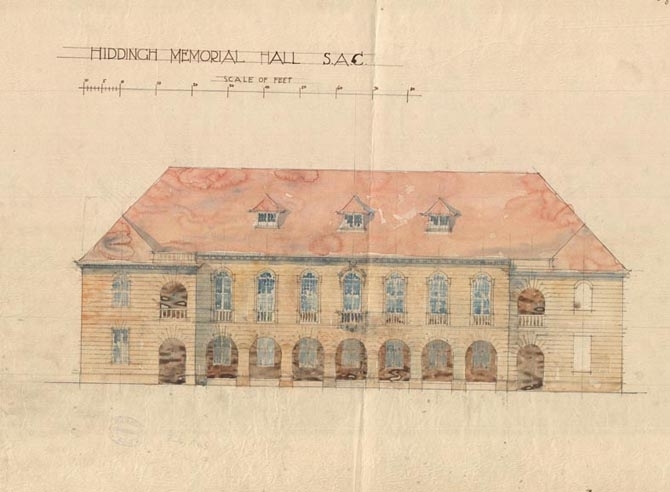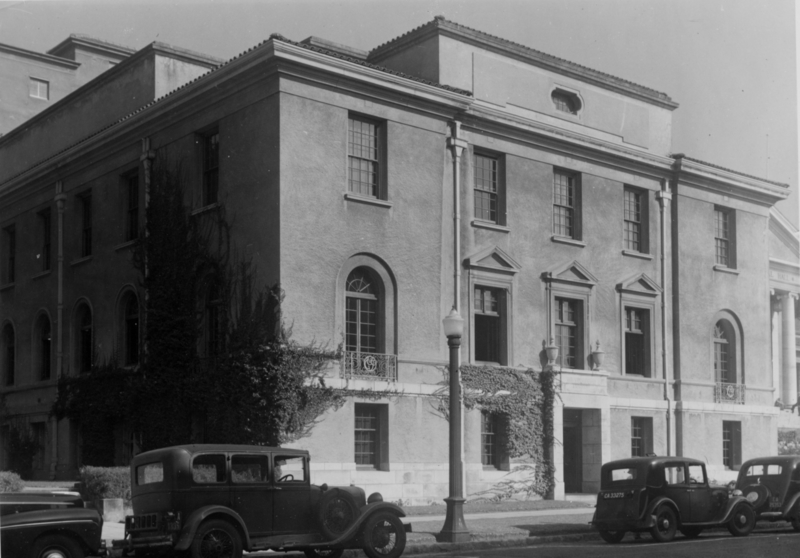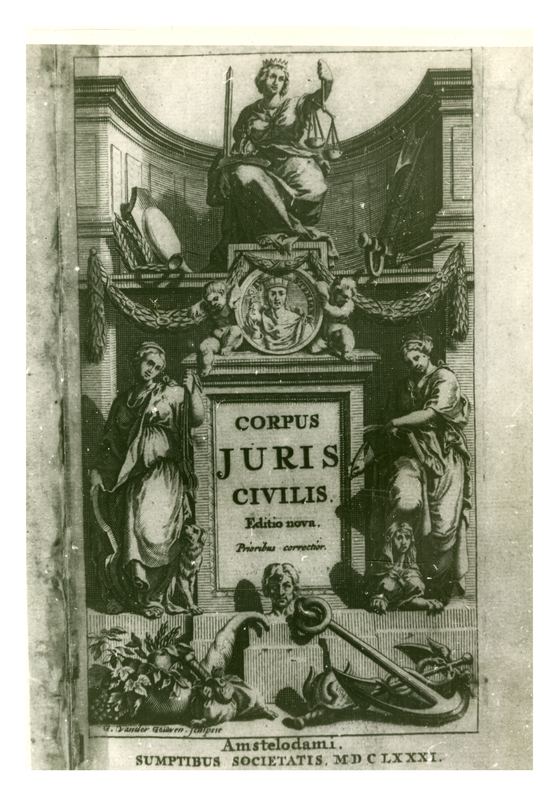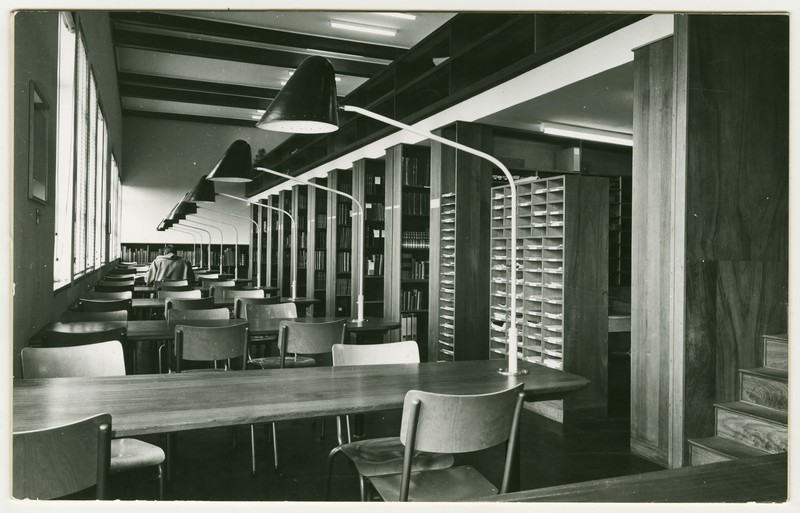Our Story
1829 - 1905
The college library came about in 1829 when the founders of the South African College first expressed the need for a library for their students. In the years to follow, the residents of Cape Town responded generously with donations of books.
Notable figures such as Professor of Law, Caspar Hendrik van Zyl, donated his legal texts’ library to his Law students. Sir George Grey also donated his collection of classical works to the College when he vacated his position as Governor of the Cape. Donations continued to grow and eventually included scientific journals from the Royal Society of South Africa.
The accumulated books eventually laid scattered between college departments and the student residence, College House. They were not well organised nor available to those who needed them.
In 1905, Professor W. S. Logeman from the Department of Modern Languages was installed as the first Honorary Librarian of the South African College. He brought all the books gathered in various departments to the old Zoology Lecture Room where he catalogued and arranged them in a systematic order. In the same year, the South African College established its first organised library in Bertram House, on its Orange street premises in Cape Town.
The holdings experienced significant growth when the Royal Society of South Africa (formerly the South African Philosophical Society) deposited its journals to the College. When the College received its first regular income, the first full-time Library Assistant, Mr S. Harvey, was appointed. Professor Logeman remained in his post as Honorary Librarian until his retirement in 1920.
1910s
Hiddingh Memorial Hall was built at the Orange street campus in 1910 and officially opened on 29 September 1911. The ground floor became the home of the College Library, the first purpose-built library of the SA College. The building was designed by the firm of Sir Herbert Baker, whose architectural plans are housed in the UCT Libraries’ Special Collections Division. The funding of Hiddingh Memorial Hall was made by a bequest from the estate of Dr W. Hiddingh.
Collection development diversified and expanded the Library holdings in 1911 when Harry Bolus bequeathed his herbarium and collection of botanical books to the South African College. By 1914, Professor Logeman noted the need to separate "special books and records" from the general stock. Thus, was conceived the idea of what was to become UCT Libraries' Special Collections Department.
College Library renamed the University Library
The funding of the University of Cape Town (UCT) was by the bequest of Alfred Beit and subsequent gifts from mining magnates Julius Wernher and Otto Beit.
UCT was established in 1916, incorporating the South African College, through the promulgation of the University of Cape Town Act of 1916, which came into force in 1918. The College Library became known as the University Library after the founding of UCT in 1918.
1920s
First full-time University Librarian appointed
After Professor Logeman retired in 1920, the first full-time University Librarian, Rev. G.F Parker was appointed. A new issuing system replaced the double-entry ledger system. Library stock was catalogued according to the Anglo-American Cataloguing Rules and classified according to the Dewey Decimal Classification Scheme. The binding of library materials was also introduced during this period.
After the medical school was established, library medical books and journals were relocated in 1928, from Orange street into three rooms on the top floor of the Pathology Block of the Wernher and Beit complex.
Mr Harvey assumed the new role as Medical Librarian from 1928 until his retirement in 1931.
1930s
By the 1930s the Groote Schuur campus (Upper Campus) began to take shape on the slopes of Devil's Peak, with the construction of many university buildings. Jameson Memorial Hall (later Sarah Baartman Hall) was built prominently in the centre of the campus.
The development of the Groote Schuur Campus necessitated the move of some of the Library books from Hiddingh Hall to the new campus. The Senate Room in the new Arts Block became the home for the bulk of the general library stock, the balance remaining in the Hiddingh Hall Library.
This evolved when the J.W. Jagger Library Building was constructed, adjacent to Sarah Baartman Hall. The building was named after one of the earliest benefactors and Chairperson of the University Council of UCT, John William Jagger, and came to serve as the main library of the University of Cape Town.
As donations continued during the 1930s, the university library grew exponentially, with increasing demands for periodical literature by academic staff and students. Provisions for more space were made in the Jagger Library, with seminar rooms for modern, classical, and African languages. This provided a conducive working and research environment for staff and senior students.
Short Loans service
Access to resources was important as a growing number of students needed access to books for their classwork. A reserved book section became especially pertinent during the war years when academic materials were in short supply. Eventually, this would become the Short Loans facility found in every branch library today.
The School of Librarianship opens
As the Library developed, its influence within the academy grew. The University Librarian, for example, began to address new students on the holdings of the library and its branches, and a pamphlet on How to use the University Library was first compiled in 1933. As the Libraries collections continued to grow, so did the demand for professionally trained library staff.
In 1939, Dr Rene Ferdinand Malan Immelman established the School of Librarianship inside the J.W. Jagger building. Formal training for Librarians was almost unknown in South Africa until the School of Librarianship opened its doors. RFM Immelman took special leave to study Librarianship at Columbia University, New York, from August 1937 to November 1938.
Library training was conducted by Douglas Varley, Chief Librarian of the South African Library (now the National Library of South Africa, Cape Town campus) and senior University Library staff, including RFM Immelman.
1940s
RFM Immelman becomes University Librarian and Director of the School of Librarianship
By 1940, the University Library had a collection of 110 000 volumes and ten staff members. A new chapter in the history of the University Libraries was heralded in by the appointment of the new University Librarian, Dr Immelman.
Over the next 30 years, Immelman became instrumental in the rapid expansion of the University Libraries into an internationally recognised Research Library with over half a million books.
The establishment of many branch libraries took place during his tenure as University Librarian.
The Music Library opened on 1 August 1943 and is the first completely self-contained, functionally-designed music library in Africa. The Music Library was an amalgamation of the music holdings of the South African College of Music and the University Libraries.
The library was initially housed in the dining room of Strubenholme, the family home of the Struben family in Rosebank. Eventually, space became inadequate for the growing music holdings and additional rooms were added.
The Music Library extension at the South African College of Music was officially opened on 7 October 1949, consisting of a Reading Room, Control Room, Record and Score Room and a Listening Room.
Donation of the Van Zyl Collection of Legal Antiquarian Materials
The Van Zyl Collection of Legal Antiquarian Materials was a significant donation by Rt Hon Gideon Brand van Zyl during the 1940s. This donation necessitated an additional wing in the Hiddingh Hall Library. The official opening of the Van Zyl Seminar room took place in 1949.
The auspicious Jagger Library was included in the British Royal family’s visit to Cape Town in 1947.
1950s
The Medical School needed a dedicated space for the growing medical materials and readers. In the 1940s, building plans were drafted for a new Medical Library.
The new Medical Library was built in 1953 and officially opened on 19 February 1954, despite construction delays due to World War II and other considerations.
The first Architecture Library occupied two wooden huts on the Upper Campus sports fields.
With the completion of the new Centlivres Building on University Avenue in 1953, it was possible to move the scattered Architectural Library material into a suitable section of the building, which the Architectural Library (now Built Environment Library) occupies today. The material included various books collections, periodicals, pamphlets, and plans.
Most historic plans and drawings were later transferred to the Special Collections Manuscripts and Archives Repository.
Special Collections Department established
In 1914, Professor Logeman had proposed an idea to separate special books and records from the general holdings. This idea became a reality in 1953 when a Special Collections department opened inside the J.W. Jagger Library.
Immelman was a well-known local historian. He collected many special collections and rare books and even approached potential donors.
The Kipling Collection donation
A retired teacher from Potchefstroom Boys High, Mr JSI McGregor, donated his Rudyard Kipling Collection to the University Libraries in 1959.
The Kipling Collection has been referred to as "one of the most important, if not the finest, of the libraries non-Africana special collections".
Immelman also acquired the Alice in Wonderland Collection, the Modern English Poetry Collection, and many others, including a collection of Hebrew texts which later formed part of the Jewish Studies Library.
Over the years, many of these collections found a home in the Rare Books section of Special Collections.
Africana Collections
A keen interest in Africana collections was a driving force for Immelman to acquire (most by donation) many African and Southern African materials of great value.
Some significant acquisitions were the C. Louis Leipoldt Collection and the Bleek & Lloyd Collection currently housed in the Manuscripts and Archives department.
African Studies Library established
Recognising the worth of UCT's Africana collections, Harry Oppenheimer donated funding for an African Studies Library and a Centre for African Studies.
The African Studies Library is regarded as a world-renowned research resource and is sought by researchers worldwide. The extensive holdings include monographs, periodicals, ephemera, pamphlets, videos, sound recordings, maps, conference papers, and newspapers.
Government Publications Collected
Immelman organised the collection of government materials into a sub-department, the Government Publications Department, which has developed into a world renowned collection of official government publications pertaining to Africa.
Other notable points
• Jagger building renovations added two half floors with the addition of a passenger lift.
• The Carleton Harrison Education Library opened opposite the Centlivres Building inside a new Education Building.
• Donation of Dutch books from the Netherlands Government on 5 June 1959.
Plans for a medical library were drawn up in the 1940s to provide a dedicated space in the Medical School for the growing medical materials and readers. The new Medical Library was built in 1953 and officially opened on 19 February 1954, despite construction delays due to World War II and other considerations.
The first Architecture Library occupied two wooden huts on the Upper Campus sports fields. The Centlivres building was constructed on University Avenue to accommodate the growing number of architectural students on campus, together with the increasingly scattered architectural library materials from various collections of books, periodicals, pamphlets, and plans.
With the completion of the new Centlivres Building in 1953, it was possible to move the architectural library material into a suitable section of the building, which the Architectural Library (today's Built Environment Library) occupies until this day.
Special Collections Department established
Professor Logeman's idea in 1914 to separate "special books and records" from the general holdings, had become a reality in 1953 when a Special Collections department was established inside the J.W. Jagger Library. Being a well-known local historian, Immelman collected many special collections and rare books, and by approaching potential donors.
The Kipling Collection donation
A retired teacher from Potchefstroom Boys High, Mr JSI McGregor, donated his Rudyard Kipling Collection to the University Libraries in 1959. The Kipling Collection has been regarded as "one of the most important, if not the finest, of the libraries' non-Africana special collections".
Through significant effort, RFM Immelman also acquired the Alice in Wonderland Collection, the Modern English Poetry Collection, and many others, including a collection of Hebrew texts which were later to form part of the Jewish Studies Library. Over the years, many of these collections found a home in the Rare Books section of Special Collections.
African Studies Library established
Immelman's keen interest in Africana collections was a driving force in the acquisition of (mostly by donation) many African and Southen African materials of great value. Some significant acquisitions were the C. Louis Leipoldt Collection and the Bleek & Lloyd Collection, which was housed in the Manuscripts and Archives department.
Recognising the worth of UCT's Africana collections, Harry Oppenheimer donated funding for the establishment of the university's Centre for African Studies and the African Studies Library.
The African Studies Library is regarded as a world-renowned research resource and is sought by researchers across the world. The extensive holdings include monographs, periodicals, ephemera, pamphlets, videos, sound recordings, maps, conference papers, and newspapers.
Other notable points
- Jagger building underwent renovations to have two half floors were added, with the addition of a passenger lift and the circulation desk was re-modelled.
- Another branch library, Carleton Harrison Education Library, was opened opposite the Centlivres Building inside a new Education Building.
- Dutch Book donation from the Netherlands Government on 5 June 1959.
1960s
Brand van Zyl Law Library opens
The Law Library opened as a separate branch library in the Ritchie Building, Hiddingh Campus in September 1962.
In the same year, the Logeman Reading Room was opened inside Hiddingh Hall Library. The room was established to commemorate Professor Logeman's contribution to the founding of the university's library system.
Other notable points
- Jagger annexe was constructed in 1964.
1970s
Mr Immelman retired from the University Library in 1970, leaving behind him a great research resource of which he and the University could be very proud. He would later be awarded an honorary doctorate for his services to the University. Miss L.E Taylor took over the role of University Librarian. She had been his deputy for many years as well as Assistant Director of the School of Librarianship.
During the next 3 decades, the Library was to change considerably.
J.W Jagger Library outgrows its space
The present overcrowded, noisy, and inadequate library facilities in the J.W Jagger Library are so notorious as to need no description.
- Library Committee, 1972
Staff and student numbers had increased dramatically in the decades following the war. The Short Loans Collection had grown; there was a need for more seating space for students. Staff also experienced cramped working conditions. Building developments commenced inside and adjacent to Jagger Building so that every available space could be exploited.
- The main reading room was remodelled to accommodate more seating and an increased Short Loans Collection.
- An additional floor was added to the Jagger Building to accommodate the technical services departments.
- Special Collections was provided with a vastly improved working area and reading room.
Linear Library constructed
The library had to expand dramatically without being moved from its central position on Upper Campus. Miss Taylor and Julian Elliott, director of the newly-formed University Planning Unit devised a creative proposal for a linear library.
- The Linear Library would be a spine of library space, running parallel to University Avenue.
- The space made it possible to place the book stock close to the appropriate teaching departments.
- The library's administrative and main services would be centralised.
Following Miss Taylor's retirement in 1974, Mrs Jean Laurenson was appointed University Librarian. Mr Barry Watts, the new Deputy Librarian, drove the building process forward.
Other building developments
- To the south of the Jagger Building, library space was provisioned in the Menzies Engineering Building and the Robert Leslie Commerce Building.
- The library components of these buildings were known as the Menzies and Leslie Extensions.
- A series of enclosed bridges linked these components to each other and the Jagger Building.
- The Science and Engineering Library moved from its cramped space on the University Avenue level of the Jagger Building to new quarters in the Menzies Extension.
- The library stock relevant to the Commerce Faculty was housed in the Leslie Extension.
- Additional Library entrances were created in the Menzies and Leslie Extensions, each with circulation desks where materials from those areas could be borrowed and returned.
Brand van Zyl Law Library and School of Librarianship moves to new P.D Hahn Building
Another development in the 1970s was the completion of the P.D Hahn Building. The Law Faculty, Brand van Zyl Law Library and the School of Librarianship moved from their original premises on Orange Street Campus to the P.D Hahn Building. Librarianship and law students jostled for seating space in their new but already overcrowded library.
Eventually, the Department of Librarianship and its book stock moved into the Leslie Commerce Building.
New College of Music and Music Library constructed
In the early 1970s, construction began for the New College of Music and its Music Library just below Strubenholme. The library is named the W.H. Bell Music Library after 'Daddy' Bell, a much-loved Professor of Music and generous donor of music manuscripts and materials.
Institute of Child Health Library opens
The Medical Library developed a specialist branch at the Red Cross War Memorial Children's Hospital in Rondebosch. The Institute of Child Health Library was established in 1974 to cater for the needs of paediatric specialists.
Other notable points
1980s
Mr A.S.C. Hooper was appointed University Librarian in 1980, following the sudden passing of Mrs Laurenson. He also faced the ever-present need for more accommodation for library stock, staff, and users. The Dewey Decimal Classification Scheme also imposed limitations on the layout of the library stock.
The Manuscripts & Archives Department used the library annexe behind Sarah Baartman Hall to store rare books and special collections, separated from the African Studies holdings.
The Immelman Building was built behind Sarah Baartman Hall in the early 1980s and linked to the Jagger Building, forming the northern component of the Linear Library. The building officially opened on 23 April 1982 and was named after Mr Immelman (University Librarian from 1940-1970), who also attended the event.
The attractive building structure with its high arched roof and huge windows became the new home of the Science & Engineering Library.
Law Faculty and Brand van Zyl Law Library moves to the Education Building
The Faculty of Education moved to Middle Campus after its development in the 1980s. Generous funding allowed renovations to the former Education Building on Upper Campus. The Law Faculty and the Brand van Zyl Law Library relocated to the building. The building was renamed the Wilfred and Jules Kramer Faculty of Law Building.
OSCAR, the first computerised issue system
The first computerised issue system, fondly known as OSCAR, was introduced in the early 1980s following the enormous task of bar-coding the circulating stock and inputting the bibliographic details of every book.
UCT Libraries first computer
UCT Libraries acquired its first computer in 1982, installed on the 6th level of the Jagger building. Librarians undertook the first online literature searches for patrons using online international databases from American and European information vendors such as Dialog and Datastar.
The Mid-1980s
While the Jagger Library was being re-configured, many moves took place, some of them temporary, but as the mid-eighties approached, changes to the library on the Upper Campus were complete.
Updates to Jagger Library
• A second entrance on an upper level.
• A new staircase linked the old Jagger Reading Room to the new circulation area.
• The circulation area became the central hub of the library on the 5th Level of the Jagger Building.
Special Collections moves
• Special Collections found a home for itself on the lowest level of Leslie Commerce Building.
• The Manuscripts & Archives Department moved into its new quarters in the Centre for African Studies in 1989.
• The African Studies Library moved into the Engineering Mall level of the Leslie Commerce Building.
Jewish Studies Library Opens
The Isaac and Jessie Kaplan Centre for Jewish Studies and Research bought book collections and journals on Jewish Studies. In 1981, the Jewish Studies Library opened to house these holdings. By the mid-1980s, the Jewish Studies Library moved to the Leslie Commerce Building, joining Special Collections.
In 1989, the Jewish Studies Library moved into its home in the newly completed Kaplan Centre, adjacent to the Leslie Commerce Building.
Faculty Library Committees and board membership
The rapidly weakening South African economy of the 1980s placed immense pressure on funding periodical subscriptions and book purchases.
UCT Libraries continued to develop and position themselves within the academic community of the University of Cape Town. Some organisational developments include Collection Development policies, Faculty Library Committees and ex officio membership of faculty boards. The first librarian being Sheila Katcher, Medical Librarian 1971-1997.
Other notable points
• The Bindery and the recently-formed Preservation Unit moved into premises on the Orange Street Campus.
• An off-campus store was acquired in Observatory to house older, less-used materials.
1990s
Administrative and technological advancements shaped many events of the 1990s. The achievement was not without the cooperation of individuals and extensive data capture and transfer projects. There were also developments in library practice, driven by the needs of financially strained institutions in the Western Cape.
Margaret Richards, Head of the Special Collections and Africana Division, became caretaker Director of the University Libraries, following the early retirement of Mr Hooper in the mid-1990s.
CALICO
Financial constraints became a driver for greater cooperation between tertiary education institutions in the Western Cape during the early 1990s. Tertiary libraries in the Western Cape could not contain all materials required by their users, even with interlibrary loan agreements in place both nationally and internationally.
The Western Cape libraries gradually moved towards a cooperative model, and in 1992 the Cape Library Co-operative (CALICO) was established. CALICO consisted of libraries of the five tertiary institutions of the Western Cape: Universities of Cape Town, Stellenbosch, and the Western Cape, and the Cape and Peninsula Technikons.
The Libraries goes Tech Savvy
BORIS (Borrowers Information System) in 1990
BORIS was an issue system integrated with the Libraries first Online Public Access Catalogue (OPAC). BORIS went live in 1990 and replaced the OSCAR issue system.
ALEPH 500 Integrated Library System in 1999
By the end of the 1990s, the Libraries was under pressure to replace the non-Y2K compliant BORIS. In 1998, UCT Libraries purchased the ALEPH 500 integrated library system that went live in November 1999. The investment was made possible by the CALICO partnership and a donation from the Mellon Foundation.
ALEPH 500 was the Libraries first web-based OPAC and accessible to users from anywhere in the world. Users were able to search the UCT Libraries catalogue and those of the other CALICO institutions. They were also able to place electronic hold requests, renew books and view their loans history via a personal login.
Ulwazi, a new Library Technology training hub
The rapid advancement of library technology prompted in-house training on new technologies for staff and students.
The introduction of electronic databases on CD-ROM instead of printed abstracts and indexes enabled users to conduct online literature searching. These technologies necessitated the need for special training facilities to teach these new techniques.
A fully-equipped training room named, Ulwazi was established in the Menzies Extension and later moved to its current location inside Vincent Kolbe Knowledge Commons.
Joan Rapp appointed Library Director
Joan Rapp was appointed new Libraries Director in July 1998, bringing with her extensive library experience from the United States. During her tenure, she breathed new life into the development of the Libraries. Her primary goal was to transform UCT Libraries into a technologically sophisticated facility, offering a wealth of electronic and print resources and a high level of professional service to its users.
2000s
Linear Library replaced with new state-of-the-art Library Complex
The Upper Campus Project was underway, and Joan Rapp was involved with the libraries component of the renovation. The Linear Library was no longer a suitable library space. There was pressure for floor space from faculties and significant costs involved in maintaining the multiple Library entrances at the Menzies and Leslie extensions.
The Linear Library transformed into a horseshoe-shaped structure embracing Sarah Baartman Hall, the centre of Upper Campus. The Jagger Building linked to its mirror-image on the north side of the Hall, the Otto Beit/Students Union Building, where the new entrance to the Main Library is now situated.
Chancellor Oppenheimer Library opens
A newly built state-of-the-art library complex was to be the centrepiece of the Upper Campus development. Fundraising took place, the most significant donor being the University Chancellor, Mr Harry Oppenheimer. The new complex of the University Libraries was named the Chancellor Oppenheimer Library Complex, honouring its benefactor, at an opening ceremony in October 2001.
The new library complex provided additional space for improved accommodation for student services, a new food court, and a centre for post-graduate research. Inside the Main Library, there were new specialist reference services, technical and user services departments, and training and research facilities.
The Rare Books & Special Collections, the African Studies Library, and the Government Publications Departments rejoined the Main Library pocket. The stock from the Education Library was also relocated to the Main Library.
Brand van Zyl Law library moves to middle campus
When the Law Faculty moved down to the Middle Campus, the Brand van Zyl Law Library joined them and moved down the hill to its current location on the middle campus in July 2000.
The Knowledge Commons
The early 2000s introduced an increase in web-based learning systems and electronic resources. Joan Rapp recognised a need for a computer laboratory for students within the library complex, with expertly trained library staff at hand.
The new computer lab was named the Knowledge Commons and modelled on those at the Universities of Southern California and Eastern Michigan.
The KC proved so popular with students that it had to be enlarged twice within the four years of its existence. The expert assistance of professional librarians was aided by a team of specially trained student "navigators".
The Knowledge Commons in the Chancellor Oppenheimer Library was renamed the Vincent Kolbe Knowledge Commons on 23 March 2017, after District Six-born community librarian Vincent Kolbe.


